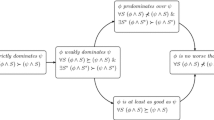Abstract
The common investment decision rules, Markowitz’s Mean-Variance (MV) rule and the non-parametric Stochastic Dominance (SD) rules, suffer from one severe drawback: there are pairs of prospects where experimentally 100% of the subjects choose one prospect, yet these rules are unable to rank the two prospects—a paradoxical result. Thus, the set of all preferences corresponding to these decision rules is too large, because it contains theoretical preferences that are not encountered in practice. Based on 400 subjects’ choices we define the economically relevant set of preference and the corresponding new decision rules, which avoid the paradoxical results. The results are very robust and are almost unaffected by the magnitude of the outcomes and the structure of the prospects under consideration.
Similar content being viewed by others
References
Allais, M. (1953). Le comportement de l’homme rationnel devant le risque: Critique de posttulats et axiomes de l’ecole americaine. Econometrica, 21, 503–546.
Bali, T. G., Demirtas, K. O., Levy, H., & Wolf, A. (2008). Asset allocation to small and big stocks. Working Paper, CUNY, Baruch College.
Barrett, G. F., & Donald, S. G. (2003). Consistent tests for stochastic dominance. Econometrica, 71, 71–104.
Baumol, W. J. (1963). An expected gain in confidence limit criterion for portfolio selection. Management Science, 10, 174–182.
Benitez, P. C., Kuosmanen, T., Olschewski, R., & van Kooten, G. C. (2006). Conservation payment under risk: A stochastic dominance approach. American Journal of Agricultural Economics, 88(1), 1–15.
Berk, J. B. (1997). Necessary condition for the CAPM. Journal of Econoic Theory, 73, 245–257.
Gasbarro, D., Wong, W. K., & Zumwalt, J. K. (2007). Stochastic dominance analysis of iShares. The European Journal of Finance, 13, 89–101.
Fishburn, P. C. (1964). Decision and values theory. New York: Wiley.
Hadar, J., & Russell, W. R. (1969). Rules for ordering uncertain prospects. American Economic Review, 59, 25–34.
Hanoch, G., & Levy, H. (1969). The efficiency analysis of choices involving risk. Review of Economic Studies, 36, 335–346.
Huang, J. (2007). Almost first stochastic dominance: what do we know from options market? Working Paper, SSRN.
Kahneman, D., & Tversky, A. (1979). Prospect theory: An analysis of decision under risk. Econometrica, 47, 263–291.
Kuosmanen, T. (2004). Efficient diversification according to stochastic dominance. Management Science, 50(10), 1309–1406.
Leshno, M., & Levy, H. (2002). Preferred by all and preferred by most decision makers: almost stochastic dominance. Management Science, 48(8), 1074–1085.
Levy, M. (2003). Are rich people smarter? Journal of Economic Theory, 110(1), 42–64.
Levy, H. (2006). Stochastic dominance: investmen decision making under uncertainty (2nd ed.). Boston: Kluwer.
Levy, M. (forthcoming). Almost stochastic dominance and stocks for the long run. European Journal of Operation Research.
Levy, M., Levy, H. (2002). Prospect theory: much ado about nothing. Management Science, 48, 1334–1349.
Levy, M., & Levy, H. (2004). Prospect theory and mean-variance analysis. Review of Financial Studies, 17, 1015–1042.
Levy, M., Roll, R. (2008). The market portfolio may be efficient after all. UCLA, Working Paper.
Maccheroni, F., Marinacci, M., & Rustichini, A. (2006). Ambiguity aversion, robustness, and the variational representation of preferences. Econometrica, 74(6), 1447–1498.
Markowitz, H. M. (1952). Portfolio selection. Journal of Finance, 7, 77–91.
Post, T. (2003). Emperical tests for stochastic dominance efficiency. Journal of Finance, 58, 1905–1932.
Quiggin, J. (1982). A theory of anticipated utility. Journal of Economic Behaviour Organization, 3, 323–343.
Quiggin, J. (1993). Generalized expected utility theory, the rank dependent model. Boston: Kluwer.
Quiggin, J., & Chambers, R. G. (2004). Invariant risk attitudes. Journal of Economic Theory, 117, 96–118.
Rothschild, M., & Stiglitz, J. E. (1970). Increasing risk: I. definition. Journal of Economic Theory, 2, 225–243.
Sharpe, W. F. (1966). Mutual fund performance. Journal of Business, 39, 19–38.
Tversky, A., & Kahneman, D. (1992). Advances in prospect theory: cumulative representation of uncertainty. Journal of Risk and Uncertainty, 5, 297–323.
Woodard, D. Lifecycle mutual funds. http://mutualfunds.about.com/od/lifecyclefunds/a/lifecycle.htm.
Author information
Authors and Affiliations
Corresponding author
Rights and permissions
About this article
Cite this article
Levy, H., Leshno, M. & Leibovitch, B. Economically relevant preferences for all observed epsilon. Ann Oper Res 176, 153–178 (2010). https://doi.org/10.1007/s10479-008-0470-7
Published:
Issue Date:
DOI: https://doi.org/10.1007/s10479-008-0470-7



